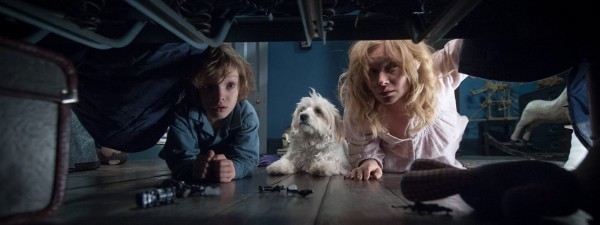The Babadook is full of nervous energy and tension from minute-one. Amelia (Essie Davis) is a single mother taking care of, honestly, the most obnoxious kid imaginable. Her husband died while driving her to the hospital to give birth, a fact which her son Sam (Noah Wiseman) is well aware. He’s the kid you see screaming in the supermarket as their parent flatly ignores them, acting out by—among other things—building weapons that he brings to school. A near-accident with one of those weapons gets Sam pulled from class and an unprepared Amelia is suddenly forced to upend her work life to accommodate her stay-at-home son. And then one night, Sam pulls a book off of the shelf that Amelia’s never seen before: The Babadook. It’s a creepy, violent story with no poetic justice at the end to assure its reader that, though the world is full of monsters, everything will be okay in the end. Sam gets obsessed with The Babadook, claiming to see the dark figure in the top-hat with the fanned, dagger-like fingers lurking everywhere around the house. At first this is all just another annoyance for Amelia, who is becoming panicked by her son’s lack of sleep, but then—after ripping out the pages of the book and throwing them in the trash—it reappears on her doorstep, now with added illustrations that show her murdering her son.
The one story I couldn’t get out of my mind while watching this was Charlotte Perkins Gilman’s “The Yellow Wallpaper,” especially given director Jennifer Kent’s use of monochromatic color. Amelia’s house is all grey and white like something from a German expressionist film. She and Sam dress accordingly, her nursing uniform camouflaging her against every wall in every room. Even in the early going, when the place feels a little warmer, a little more like a home, there’s a sense that the place is just on the verge of being rundown. But as dishes pile up in the sink and Amelia discovers a nest of roaches behind the wallpaper, her state of mind starts a more overt feedback loop with the house. The state of things are running her down, which makes it harder for her to take care of herself and her son, which in turn runs her down even more.
I don’t know enough about post-partem depression to accurately call that out as the chief design of the film, but there’s certainly something going on here that extends beyond a simple boogeyman story. Like Brad Anderson’s Session 9, the characters are already coming from a strained emotional place before the inciting incidents tip them over the edge into something potentially more supernatural. The Babadook as a character becomes more of a magnifying glass on the existing tensions between Amelia and her son, whom she resents for the death of her husband (saying nothing for how outwardly awful tends to be). That makes the emotional trajectory for the characters—particularly Amelia—very clean and traditional, but remarkably effective as the tension rises. There’s a tremendous moment when, after burning a copy of the book, Amelia shows up in a police station, panicked and unkempt. The ash from the book is still on her hands and as she notices that the police are looking at her like a crazy person, she pulls her hands back, trying to hide them in an embarrassed moment of self reflection. The scene communicates a crossing of a rubicon for Amelia, but also, in the tradition of Rosemary’s Baby, speaks to a world where hysterical women are easily brushed aside and ignored. Whether Amelia’s threat is internal or external, she’s going to have to handle it alone.
Essie Davis is asked to do a lot with Amelia throughout the course of the film and she pulls off everything from being a demure single mother, to some moments that require a bit more frothing at the mouth. Maybe it’s the benefit of not knowing her previous work, but everything feels connected and grounded within the context of the character. Noah Wiseman is good in a different way as Sam, a character that, were his obnoxious behavior not so integral to the story, he would easily make the film unwatchable. Not liking his performance because it’s too obnoxious would be like not liking the characters in A Clockwork Orange for being too mean. But the real star of the film is writer/director Jennifer Kent, who never once loses sight of her story and exercises remarkable control. Everything from the color palette—which is as plaid as a body drained of its blood—to the performances, to the sound design; it’s all expertly done and I’m excited to see more from her in the future, especially if she maintains an allegiance to the genre. But like Jeff Nichols, her ability to manipulate an audience with this kind of psychological filmmaking is going travel well outside of horror and allow her to tell all sorts of different stories.
The Babadook is in theaters and on VOD now. I can’t stress enough how important it is to see this film with an audience, with the sound pumping and your complete attention paid to the screen. This is the best horror film of the year and if it’s playing anywhere remotely near you (I drove 30 miles to see it), you should.
